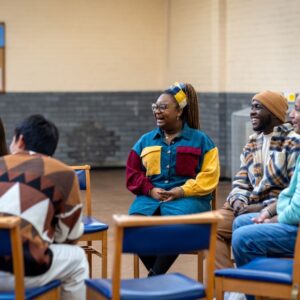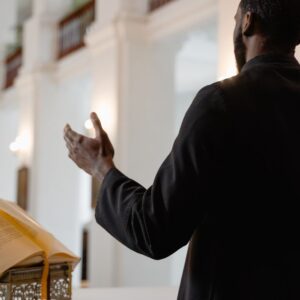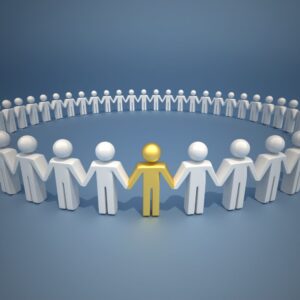This article is an excerpt from an interactive discussion with Organizational Psychologist and Executive Coach Dana Scannell, PhD and Dr. Rose Madrid Swetman, of the Center for Transforming Engagement. Dana and Rose share the challenges they hear as they do consulting work with teams, clergy, nonprofit leaders, and people that used to be leaders and are now deconstructing their faith.
How to appreciate difference on a team
ROSE: We’re going to start today by addressing something that is coming up no matter where you are. It could be your family, it could be a team you’re leading, it might be your church or your place of business. I don’t know if all of you have noticed, but right now there is a lot of holding differences. We are seeing increased polarization and big gaps around difference going on, especially in teams. So one of the things I wanted to ask Dana is when you’re coaching a leader, how do you help them understand and appreciate differences on the team?
DANA: Yeah, I love it, Rose. Thank you. I think that’s probably one of the most often and suggested questions that people have. How do I understand and appreciate the differences?
The foundation that I come from around that is really about trying to think of the other, trying to think of the other person and where they are coming from. I know I have my biases, I know I have my agenda, I know I have my frameworks, I know I have the experiences of my life and what’s worked, and what hasn’t worked.
Learn more about Best Practices for leaders
I know I’m bringing all that in and I need to acknowledge that right up front. But the biggest opportunity that I have is that we get to partner with people on this idea of trying to see people for who they are – in the fullness of who they are.
People don’t always experience that. Whatever the population, most people have experiences in their life that they can think of where that person or that group, that team didn’t see me well and recognize the power of differences. They come more experientially from a background around positive psychology.
Acknowledging our lenses
The lenses that I see the world through are important for me to understand.
And I know we can’t swap lenses, and that’s not gonna help us create focus. ButI like the idea of understanding things from the positive aspects. I think we spend so much of our time either looking at TV or in the news or whatever, and all we see are places where it isn’t positive. It’s rarely do we see that. And so our world feels very overwhelming.
And I think we have to remember as leaders that we have to try to dispel some of that, to put some of that aside to the best of our ability. Name what is, because I have to acknowledge if I’m going into a tough conversation with somebody. The world is getting more and more frightening. The more polarized we all feel, the more this is gonna be the challenge. But for understanding the differences, there’s no magic formula.
It’s thinking about how that person woke up this morning. What’s the world that they’re experiencing, and what do they bring with them that’s causing them to act and respond and behave the way that they are? And if I can try to dispel some of that bias or help them see some of that bias, not by pointing it out, but more pointing out my own challenges, my own bias.
Meeting people where they are
So part of it, I think, to understanding and appreciating differences is really around sharing and being willing to meet people where they’re at, partially because I’m not the expert. You know, the definition of expert, right? Everybody heard that formula? So X is an unknown, and a spurt is a drip under pressure, right? So an expert is a drip under pressure. So I’m not the expert, and neither’s Rose. We are fellow soldiers, fellow soldier-ners, along a journey, along a path.
And I think the golden rule comes into play. How do I appreciate people for who they are and treat people the way that I would wanna be treated? I’ve worked in some very tense situations, teams, environments, and cultures. By trying to seek first to understand, and then be understood – almost at times that feels like throw a away statement – but if we can embody it, what does that feel like?
What does that look like? How do I truly listen? How do I truly understand and truly get to experience the shoes that the person walks in, then I can try to have a chance of us meeting? And the same with teams. I use this personality profile to help me get there sometimes more quickly, but some of us have those available and some don’t, it’s not required.
Sometimes tools can help us try to see our similarities but also see our differences and allow those differences to become strengths. If I’m really good at this, and you’re really good at that, and I see the world this way and you see the world that way, we can blend them both together, we’re gonna get to see things much more powerfully because we’re gonna get to understand the whole picture instead of the world through my own lens and not just yours.
ROSE: You said so many great things there, and as you were talking, a couple of things that came up for me. One, when you first talked about the lens that we look through and trying to understand that people might see it through a very different lens, depending on where we’re coming from, how we’ve been formed. There’s this one little thing I do with a team where I will draw a circle and put three dots across the circle. And then I just have everybody look at that circle and write down everything that they see. After like a minute of everybody doing that, I go around the room and the things like people see a donut or a bagel. They see railroad wagon wheels, just so many things.
But at the end of that we all were looking at the same picture, but look at how many different perspectives there were. So it’s a perspective exercise to show we all come with a certain lens how we see the world. So I love that you said that because getting a team to understand that is super important, I think, for, yeah, just for team unity and purpose and priority and all the things. Being able to understand perspective and appreciating differences, instead of fighting against them, being able to lean in and really.
Lean into everyone’s strengths
I also like that you said about using assessments. For me, that’s helpful when I’m working with a team. It shows, oh, you’re really good at this and I’m really bad at that. So instead of me, you know, being in a lane that I’m really weak in, my team just steps in because they are so strong. And I am not, which is to your point. Just because you’re leading a team doesn’t mean you’re the expert at everything. We have to allow the team to use their skills and gifts that they’ve been given to be a part of that team. So I really like that.
DANA: I love that, Rose, and you just touched on something I’m gonna build on too. Yeah, it is the idea of strengths, capitalizing on what my strengths are and what your strengths are, and the two of us together are gonna be one plus one equals 10 instead of one plus one equals two.
And I think that’s where the idea of looking for the positive comes in – looking at strengths and looking at those opportunities for the areas where you’re better at that, or you’re good at that. And looking also for the places where somebody’s overused strength can potentially become a weakness.
Being mindful that I can be really good at this, but if I am just like a bulldog and am moving at something only one direction, and take a few people out along the way, well, that’s not gonna be helpful either. So that idea of looking at strengths, looking at places where we can align with each other and empower each other and try to see things.
One wise mentor of mine who created that instrument that I referred to that I use a lot, it was Dr. Roger Berkman, he was a fighter pilot in World War II, and he was shot down. And he had time, he was taken in by a family in Belgium and protected from being captured. And they were a very, pretty well-to-do family in town. And so he had a lot of chance to sit and read in the library and basically had a pretty amazing experience getting to think about.
Perspective as a tool to appreciate difference
And what is similar Rose to what you just said, where that tool came from was this idea of perception. He was a B-17 pilot flying the same missions in the same places, in formations in the same places. And what fascinated him to create that tool was by experiencing the same things, and then doing after action debriefs. And in those conversations, what he started to realize was that they were in the same place, doing the same thing at the same time and had such vastly different experiences. And that led to the curiosity to see the power of difference.
And so he had lots of quotes, but one of them that I love is this idea of that when we get a proper framework, a proper experience of our perceptions, our perspectives start to change – the perspective that I have, when I start to see you for who you are. And I think leaders sometimes forget that because it’s not the old days of my grandparents, where if you were the leader of something, that was your job.
Now we have leaders who carry multiple responsibilities, multiple hats. You know, I’m the leader of something, but I also have a lot of do function, not just lead function. And so how do I allocate that? How do I lead and understanding differences when I’m so focused on getting the stuff that I also need to get done? And how do I empower other people to get their stuff done when I’m not always mindful because I’m so focused on what’s my job?
———————-
A major part our work at the Center is to develop healthy, trustworthy teams and organizations to tackle your community’s most pressing problems. Learn more about our programs for teams and coaches.











0 Comments